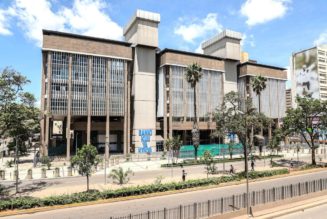Economy
AfDB gives funding for four-lane Kisumu-Uganda expressway
Friday February 17 2023
Pedestrians walk on the 3.4 Km dual carriageway under construction on Kisumu-Busia road. PHOTO | JACOB OWITI | NMG
The East African Community (EAC) has received Sh175.4 million ($1.4 million) for a feasibility study on building a four-lane expressway for Kisumu to Uganda through Busia in an upgrade targeted to boost regional integration, trade and economic development.
The funds from the African Development Bank (AfDB) will be used to assess the viability of the 256km road that will terminate in Kakira—a town in Uganda’s border district of Jinja.
The road is part of improvements on the Northern Corridor, a key trader route in East Africa providing landlocked countries like Uganda with faster access to the port of Mombasa.
“The funding from the African Development Bank would be used to conduct feasibility studies on the 256km multinational Kisumu-Kisian-Busia/Kakira-Malaba-Busitema-Busia expressway project,” said EAC Deputy Secretary General for Planning and Infrastructure Steven Mlote in a statement.
“The proposed intervention in this segment consists of the rehabilitation of the existing road two-lane single carriageway to bitumen standard while upgrading it to a two-lane double carriageway along 104 km.”
The 104km four-lane stretch will run from Kisian in Kisumu to Busia border town. The project will see the construction of an 11km link road between Kisian and Kisumu bypass.
Another 127 km will be built between Jinja and Malaba, which will be connected to a 20km stretch that will run along the border to Busia.
The high-speed highway will be the continuation of the $1.48 billion Kampala-Jinja expressway, which is expected to be completed by 2025.
A private concessionaire will be procured for a period of 30 years including an eight-year construction period on a design-build-finance-operate-transfer basis under a PPP model, where motorists will be expected to pay a toll to access the Kampala expressway.
It is not clear whether the four-lane expressway from Kisumu to Uganda will be a toll road.
The roads form part of the Mombasa–Nairobi–Kampala–Kigali expressway which was given a high priority at the 4th EAC Heads of States Retreat on Infrastructure Development held in February 2018 in Kampala.
The goal is to cut the cost of transport and boost trade. East Africa now boasts some of Africa’s fastest-growing economies, with inefficient transport often seen as one of the major obstacles to expanding businesses.
The Mombasa port is a major trade gateway to East Africa and handles imports such as fuel for Uganda, Burundi, Rwanda, South Sudan and the eastern Democratic Republic of the Congo.
Read: Uganda ships maiden fuel cargo from Kisumu port
Kenya, which faces increasing competition from other countries like Tanzania and Djibouti in the bid to serve land-locked and rapidly-growing neighbours, is banking on increased port efficiency in its infrastructure plan.
It is expected that once these road sections are rehabilitated, they will generate various direct positive effects including savings in vehicle operating costs and road maintenance expenditure.
Their rehabilitation is also expected to boost most sectors of economic activity in their areas of influence, including imports, exports, mining, forestry, production and delivery of manufactured products, trade in livestock and fisheries, goods and industrial products and tourism.
In the ten months to October 2022, Uganda was the biggest market for Kenyan goods that include coffee, tea and other edible products.
Earnings on exports to Uganda stood at Sh66.1 billion in the review period, a 10 per cent rise from Sh59.9 billion earned over the same period in 2021.
Kampala’s list of imports from Kenya has however been narrowing over the years as investors set up factories in the country to manufacture goods previously bought from Nairobi, including edible oils and cement.
Kenya relies on imported eggs from the landlocked nation where prices are fairer compared to the pricing locally given the high cost of production that has seen several farmers cut on output.
The Ugandan minister of Agriculture Frank Tumwebaze said Kenya and Uganda are at an advanced stage of trade talks that would eliminate non-tariff trade barriers in agriculture commodities that have impacted trade between the two nations.
The feasibility studies funded by AfDB for the road sections are through the NEPAD –IPPF Facility which supports African countries to prepare regional infrastructure projects in energy, transport, ICT and transboundary water.
Read: Posh Nairobians wrong on Expressway
The EAC formally submitted its request to NEPAD-IPPF in February 2021 for the financing of consultancy services for carrying out the feasibility studies of the Multinational expressway project.
The contractors’ services to undertake the feasibility study were procured in August 2022 which was done through a Request for Expressions of Interest (EOIs) in line with AfDB rules and procedures.









